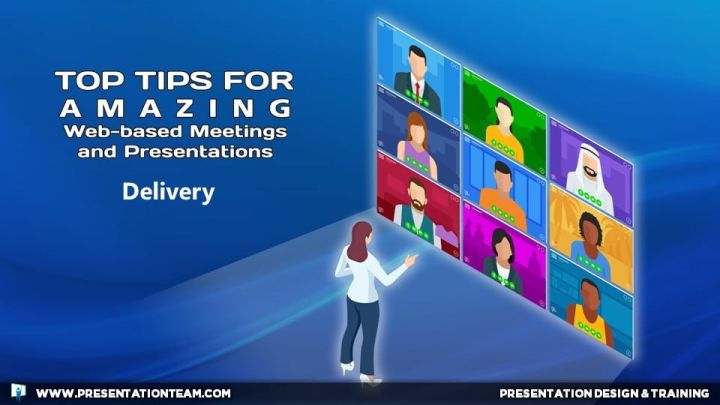Top Delivery Tips for Amazing Web-based Meetings and Presentations

Delivering online meetings takes more effort and involvement than in-person meetings. Keeping your audience engaged requires a greater effort of skills and awareness to maintain audience engagement.
Here are some ideas for delivering a web-based meeting / webinar / presentation that keeps your audience engaged, focused, and entertained.
1. Look at the camera, not the screen

It’s been said that “the eyes are the window to the soul.” At a physical meeting, eye contact is crucial to connecting with your audience. In a web-based meeting, most people are looking at their audience members on a monitor. But you can still achieve eye contact in a web-meeting, simply by looking into the lens of your camera. Indeed, the camera is your connection with your audience, promoting a two-way bond of interaction, intrigue, and trust.
Just as news anchors appear to be looking directly at you when delivering the news, you can appear to be looking directly at your audience by talking to the camera, not the screen. This small shift in the eyes – from looking down, to looking directly at you – will have a measurable impact on your perceived authenticity and professional delivery.
2. Be focused yet flexible

There is an expression “where your attention goes, energy flows.” If you’re facilitating the web meeting, keep your attention fully focused on running the meeting. Work to avoid distractions and interruptions. Silence your mobile devices, and treat your meeting and audience with the same reverence and respect that you would have in-person.
Even the process of taking notes can be a distraction. You might miss a key point, or be perceived as if you’re not paying attention. Delegate someone who’s not presenting to take notes. Or record the event so that you can go back and review the meeting again and jot down the critical points or action items.
If something turns sour, take a leadership role and manage the meeting with authority and flexibility. Do what needs to be done to keep things on-track, and communicate clearly about the next steps and followup items.
3. Encourage audience participation and play the role of the director

Although your audience should be muted, you should still elicit their input. Encourage them to participate by “raising their hand” if they have questions or comments. You can un-mute them if you want them to talk. Alternately, have them submit feedback and questions using the chat window. Gaining the input of your audience and other meeting participants enriches the delivery of your meeting and creates a more varied conversation.
Play the role of director by envisioning yourself as a radio talk show host, controlling the flow of dialogue while ensuring the meeting stays on time and topic.
4. Present with a partner

Your meeting will be far more engaging if you’re able to deliver your program with a partner. Just as most local news shows have a team of two anchors who alternate between reading stories, you can add interest and variety to your web-based meeting or presentation by partnering with a colleague. You can talk for a few minutes then toss it to your partner for another portion of the program. It takes more planning and coordination, but it’s a surefire way to keep your audience attentive with a more fun and engaging meeting.
5. Use short sentences and simple words

When presenting online, aim to keep your delivery short and simple. There’s no need to impress people with your varied and voracious vocabulary…save that for documents. Complex words and compound sentences are harder to follow orally than in print. Aim for a more general word choice using shorter sentences that have an easy-to-follow structure and logic.
Other delivery points:
- Spell out acronyms or repeat them to ensure people hear them correctly.
- Try to talk in shorter segments and reduce run-on sentences.
- One long sentence could be split in two.
- Repeat key messages worthy of remembering. Pause. Breathe. Let the messages connect.
Cultivating your unique cadence, rhythm, and delivery style can help forge your reputation as a skilled speaker and meeting professional.
6. Be respectful of time and schedules

With a respect to people’s schedules, start your meeting close to its scheduled time, and aim to cover all the topics so you can end on time. If there’s something or someone that’s delaying your meeting, or points that still need to be covered, survey the audience if you can extend the time without difficulty.
7. Avoid crutch words

Just as crutches support a person from using their injured legs, Crutch Words support a person with empty words. Often called “fillers,” words like “ummm” and “ah” weaken delivery and can detract from an otherwise tight and focused message. Become aware of how often you search for a word, filling the gap with a ummmm. Also become aware of how speakers and celebrities speak, usually with a minimal use of crutch words.
The reduction- and eventual elimination- of crutch words will add depth and dimension to your delivery by helping you sound more prepared, clear, and cohesive. Try to catch yourself saying them, or join a Toastmasters club, where most meetings have an “ah counter” to track filler words. Over time, your ummms will go down and the caliber of your speaking will go up. Check out this article for more on crutch words.
8. Vocal variety: Vary your pace, pitch, and tone for maximum impact when speaking

You can add emotion and variety to your web-based meeting by changing the sound of your voice using different speeds and tones while speaking. It’s called vocal variety, and it helps keep the audience engaged and clues them in on your meaning, feelings, or emphasis. Here are five aspects of sound that create vocal variety:
Cadence: The way you end a sentence. Variety is found in open versus closed cadence.
Speed: The pace at which you speak. Variety is found in fast versus slow pace. Also, aim to pause to add impact to key points.
Volume: Variety is created by contrasting loudness and softness of speech.
Pitch: Variety is created by using more range in your speaking voice. Every sound you make has a pitch.
Duration: Variety is created by accentuating or varying the length of the sounds created.
9.Use gestures and facial expressions for greater emotion and retention

Body language plays a big role in traditional speeches. Effective speakers use gestures and facial expression to drive emotion, enhance retention, and deliver with dimension. But in our corona meeting world, body language is limited to a small space on screen.
A wide-arm gesture will go out of bounds of the camera, so keep your gestures hands within range of your camera. Explore your presentation boundaries with a few practice sessions. And although the camera view can be mirrored, the view – especially with an external camera – is often opposite from what you’re presenting. So left is right, and right is left.
Facial expressions are another great way to amplify your delivery. Study how ASL interpreters enhance their delivery and enforce the message through their rich facial expressions. Integrating gestures and facial expressions can help you to create an online meeting that’s more meaningful and memorable.
10. Be an active facilitator

When verbally interacting with virtual participants, use their name to address them. This not only pulls that participant more into the meeting but identifies that participant to others and serves as a direct reminder to all that the named participant is actively engaged.
Actively leading the meeting – paraphrasing comments, calling on people, periodically referring to the agenda noting what’s been accomplished so far and what remains to be addressed – creates a more dynamic virtual meeting. When posing a question to the group, don’t be afraid to call on people. Active facilitation will keep people motivated and alert.
best practices, covid, delivery, presentation delivery tips, presentations, tips, web-based meetings, web-based presentations, webinars



























